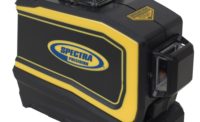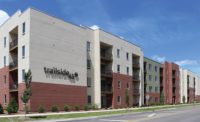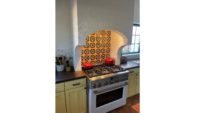Separated by more than 1,800 miles across Canada, Rogers Place, serving as the new home to the NHL Edmonton Oilers, and the new Global Innovation Exchange in Waterloo, Ontario shared similar interior challenges. Each project presented curving, complex walls and ceilings, sometimes in cavernous space or with multi-tiered floors or no floor at all. Each had to be completed on a tight schedule. Two separate interior systems contractors working independently report finding a new more efficient layout system that is significantly faster and more accurate than traditional and conventional layout methods using tapes and manual lasers. The new method was found to be significantly faster and more accurate than traditional and conventional layout methods.
Wilfrid Lauier University
In eastern Canada, the Global Innovation Exchange, in Waterloo, Ontario, is a $75 million, 215,000 square-foot state-of-the-art educational facility on the Wilfrid Laurier University campus that includes a 1,000-seat auditorium, nine lecture halls, computer labs and faculty offices. 65-year-old-family firm, Grassing Drywall and Acoustics Ltd. of Waterloo, won the interior contract for the building. It included two particularly interesting layout challenges: a central atrium with an undulating, multi-tiered serpentine, curved ceiling; and a 300-seat lecture hall with a multi-tiered floor under a multi-tiered 60-foot diameter inverted dome ceiling.
Last autumn, about the time that Grassing Drywall was fully engaged in the Global Innovation Exchange Project, Rob Grassing, a great-grandson of the founder, had read about the new Spectra Precision QML800 layout system. The system uses two intersecting lasers and claims to easily and speedily mark layout points even on complex shapes, such as ceiling arcs, circles and serpentine curves. This was precisely the kind of work the Global Innovation Exchange Building offered in abundance. He recommended trying the product to management, and the reply came back, “If you think it will work, go ahead and get it.”
“We had just finished laying out the central atrium with a ceiling of multiple ten-tiered serpentine curving soffits. It had taken us 32 man-hours–two men, two days–using the conventional tape measuring methods we are very experienced and skilled in using,” says Grassing. He decided to verify the claims made for the QML800 by putting it to the same test to compare layout times.
“After about 30 minutes of training during which we loaded the architectural CAD file, we laid out the same curved ten-tier ceiling job with one man in only four hours–a savings of 28 man-hours,” says Grassing. “We achieved that speed even though we were permitting several co-workers to take turns with the unit to gain familiarity with the instrument.”
The two lasers of the QML800 system create a bright visible “X” directly on the point for easy, quick marking. The lasers are controlled by the mobile application running on an Android tablet that stores the point files. When a point is selected, the lasers position the “X” at that point in less than five seconds. For the approximately 1,600 square-foot atrium ceiling, more than 300 points were marked within the four-hour period. Because each point is laid out independently, compounding errors from one point to the other that can occur with tape measurements are eliminated.
Another particularly difficult challenge that Grassing faced in the Global Innovations Exchange building was a multi-tiered, 65-foot diameter, inverted dome ceiling over a multi-tiered cafeteria floor. “We were able to layout approximately 300 points for this ceiling within six hours,” says Grassing. Adding, “I don’t even know how we would have completed the job without the aid of the twin robotic lasers.”
Edmonton Oilers Arena
Across Canada in Edmonton, Alberta, Groupe Piché, a known force in the Canadian construction industry, mainly known for its specialized work in interior systems in institutional, commercial and industrial projects, is completing work on Rogers Place. In the heart of the downtown, Rogers Place is a 819,000 square-feet, seven-level arena with a ceiling height of 141-feet.
The arena, seating 20,000 for concerts and more than 18,000 for hockey, and surrounding corridors, with its curved walls and ceilings within an open seven-level, sports arena presented a difficult job for conventional measuring devices. Early in the project, Groupe Piché sought a new way to improve speed and job performance. An on-site demonstration convinced management that the laser system would make a difference.
Marc Boudreau, the on-site leader who has been on the project since June, operates the laser and supervises a crew that ranges from 100 to, at times, nearly 200. The engineering project coordinator, Ana Para, loads points into the QML800 from the CAD files provided by the architects. Boudreau, who has more than 20 years of experience in drywall construction, says that it’s the first job he’s ever used the laser system, and that he found it very easy to operate. “Everything in this building is curved with some of the radii reaching up eight stories from the middle of the ice which simply can’t be conventionally tape measured,” said Boudreau. He noted that the benchmark is in the center of the ice rink on a floor that hasn’t even been built yet–a particularly difficult situation for a conventional tape measurement. Yet with the benchmark for the project set in the center of the ice rink, the laser layout system is performing efficiently and flawlessly according to Boudreau.







Report Abusive Comment